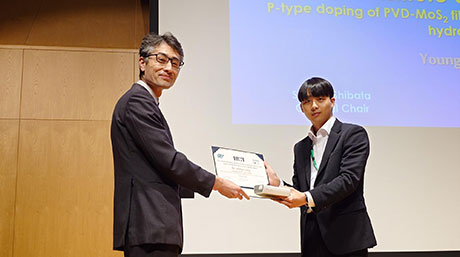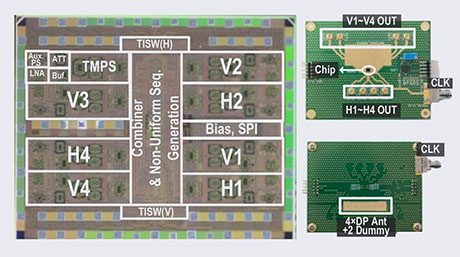Electrical and Electronic Engineering News
Improving the Performance of Satellites in Low Earth Orbit
On-chip distributed radiation sensors and current-sharing techniques can be used to reduce the impact of radiation on the radio and power consumption of small satellites, respectively, as shown by scientists from Tokyo Tech. Their findings can be used to make small satellites more robust, which can increase the connectivity of networks across the globe.

A database updated in 2022 reported around 4,852 active satellites orbiting the earth![]() . These satellites serve many different purposes in space, from GPS and weather tracking to military reconnaissance and early warning systems. Given the wide array of uses for satellites, especially in low Earth orbit (LEO), researchers are constantly trying to develop better ones. In this regard, small satellites have a lot of potential. They can reduce launch costs and increase the number of satellites in orbit, providing a better network with wider coverage. However, due to their smaller size, these satellites have lesser radiation shield. They also have a deployable membrane attached to the main body for a large phased-array transceiver, which causes non-uniform radiation degradation across the transceiver. This affects the performance of the satellite’s radio due to the variation in the strength of signal they can sense—also known as gain variation. Thus, there is a need to mitigate radiation degradation to make small satellites more viable.
. These satellites serve many different purposes in space, from GPS and weather tracking to military reconnaissance and early warning systems. Given the wide array of uses for satellites, especially in low Earth orbit (LEO), researchers are constantly trying to develop better ones. In this regard, small satellites have a lot of potential. They can reduce launch costs and increase the number of satellites in orbit, providing a better network with wider coverage. However, due to their smaller size, these satellites have lesser radiation shield. They also have a deployable membrane attached to the main body for a large phased-array transceiver, which causes non-uniform radiation degradation across the transceiver. This affects the performance of the satellite’s radio due to the variation in the strength of signal they can sense—also known as gain variation. Thus, there is a need to mitigate radiation degradation to make small satellites more viable.
Fortunately, a team of researchers led by Associate Professor Atsushi Shirane of Tokyo Institute of Technology (Tokyo Tech) have reported a novel phased array receiver strategy to reduce the effects of radiation degradation in these satellites. Their findings have been shared and published in the 2023 International Solid-State Circuits Conference. Dr. Shirane explains, "We propose a new phased array receiver strategy which involves on-chip distributed radiation sensors and current-sharing techniques. This helps to drastically reduce the effects of radiation degradation on the radio and power consumption."
The team of researchers found out that in the conventional design of the phased-array transceiver on small satellites, the signal from the main lobe degraded by 3.1 dB in a year due to ionizing radiation. To solve this the researchers created a phased-array transceiver with on-chip distributed radiation sensors. These sensors can detect the gain variation between the chips of the antenna. This was combined with current-sharing techniques to mitigate the gain variation and thus reduce the impact of non-uniform ionizing radiation on the radio and power consumption. Upon testing this new strategy, the researchers found that it led to less than 10% of the typical gain variation seen in small satellites. The current sharing techniques also brought down the power consumption of the satellite to the lowest reported value. Overall, this strategy was able to reduce the main lobe degradation and bring down gain variation while using a minimal amount of power, solving two major problems faced by existing small satellites.
"Using the distributed on-chip radiation sensors and the current sharing techniques, we were able to drastically reduce the impact of radiation degradation and make the phased-array transceiver more energy efficient. This strategy," concludes Dr. Shirane, "was found to be comparable to other state-of-the-art technologies at reducing gain variation. Thus, we believe that given its performance and efficiency, our strategy may lead to an even greater number of small satellites in lower Earth orbit, and a more well-connected world."
We have our fingers crossed for this future!
- Reference
| Authors : | Xi Fu1, Dongwon You1, Xiaolin Wang1, Michihiro Ide1, Yuncheng Zhang1, Jun Sakamaki1, Ashibir Aviat Fadila1, Zheng Li1, Yun Wang1, Jumpei Sudo2, Makoto Higaki2, Soichiro Inoue2, Takashi Eishima2, Takashi Tomura1, Jian Pang1, Hiroyuki Sakai1, Kenichi Okada1, Atsushi Shirane1 |
| Title : | A 2.95mW/element Ka-band CMOS Phased-Array Receiver Utilizing On-Chip Distributed Radiation Sensors in Low-Earth-Orbit Small Satellite Constellation |
| Conference : | 2023 International Solid-State Circuits Conference |
| DOI : | N/A |
| Affiliations : |
1 Tokyo Institute of Technology 2 Axelspace |
|
* Corresponding author's email: shirane@ee.e.titech.ac.jp |
|
- New Transmitter Design for Small Satellite Constellations Improves Signal Transmission | Tokyo Tech News
- Novel Architecture Can Reduce Noise-Induced Jitters in Digital Technology | Tokyo Tech News
- New and Improved Multi-Band Operational Receiver for 5G New Radio Communication | Tokyo Tech News
- Efficient Satellite Downlink with a Ka Band Dual Circular Polarization Transmitter | Tokyo Tech News
- Electricity and Data Over-the-Air: The Simultaneous Transmission of 5G and Power | Tokyo Tech News
- Introducing a Transceiver that Can Tap into the Higher Frequency Bands of 5G Networks | Tokyo Tech News
- Lean and mean: Maximizing 5G communications with an energy-efficient relay network | Tokyo Tech News
- Pushed to the Limit: A CMOS-based transceiver for beyond 5G applications at 300 GHz | Tokyo Tech News
- Greater Connectedness in Remote Areas: A Ka-band Transceiver for Satellite Communications | Tokyo Tech News
- Smallest all-digital circuit opens doors to 5 nm next-gen semiconductor | Tokyo Tech News
- A more accurate, low-cost 39 GHz beamforming transceiver for 5G communications | Tokyo Tech News
- Gearing up for 5G: A miniature, low-cost transceiver for fast, reliable communications | Tokyo Tech News
- Tinier and less power-hungry quantum atomic clock push toward intelligent IoT | Tokyo Tech News
- Shirane Lab.
- Okada Lab.
- Atsushi Shirane | Researcher Finder - Tokyo Tech STAR Search
- Kenichi Okada | Researcher Finder - Tokyo Tech STAR Search
- Takashi Tomura | Researcher Finder - Tokyo Tech STAR Search
- Laboratory for Future Interdisciplinary Research of Science and Technology (FIRST)
- Institute for Innovation Research (IIR)
- Electrical and Electronic Engineering Graduate Major|Education|Department of Electrical and Electronic Engineering, School of Engineering
- Electrical and Electronic Engineering Undergraduate Major|Education|Department of Electrical and Electronic Engineering, School of Engineering
- Axelspace
- Latest Research News
School of Engineering
—Creating New Industries and Advancing Civilization—
Information on School of Engineering inaugurated in April 2016
Further Information
Associate Professor Atsushi Shirane
Institute of Innovative Research,
Tokyo Institute of Technology






